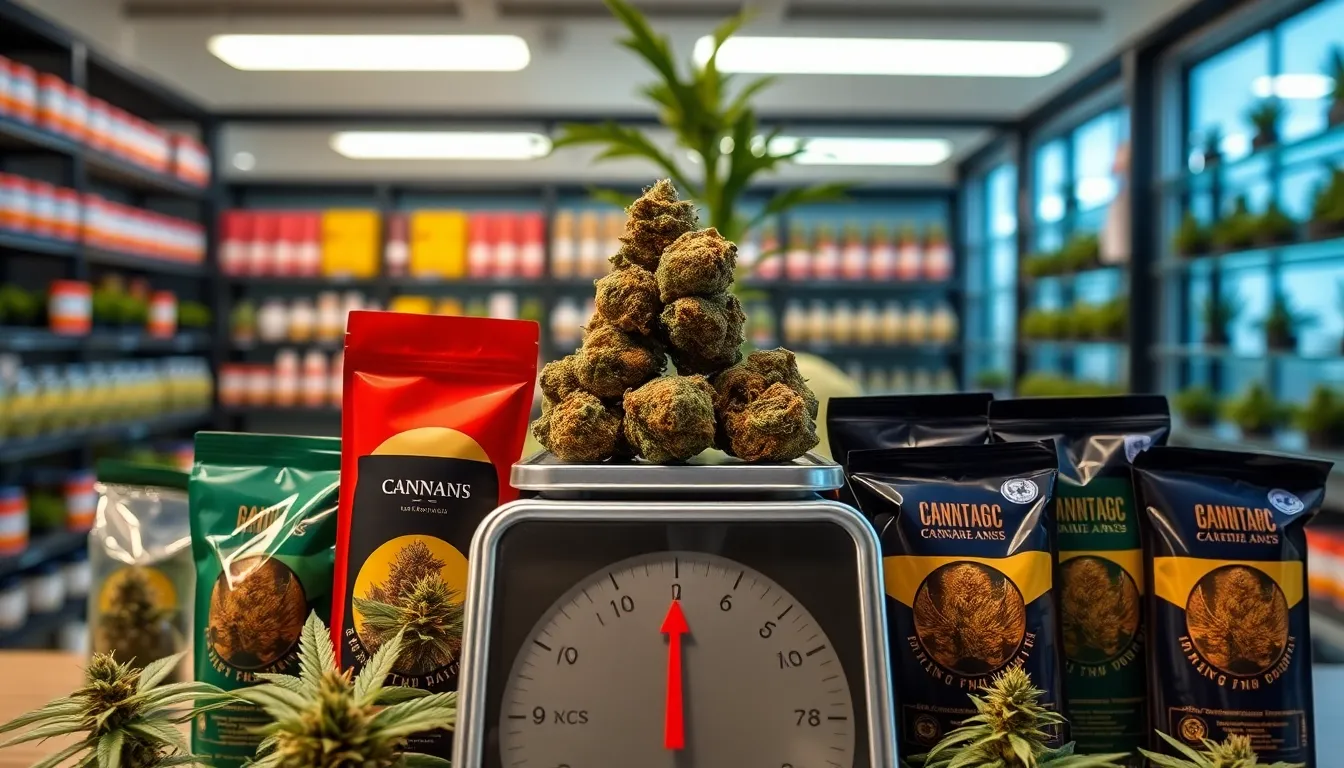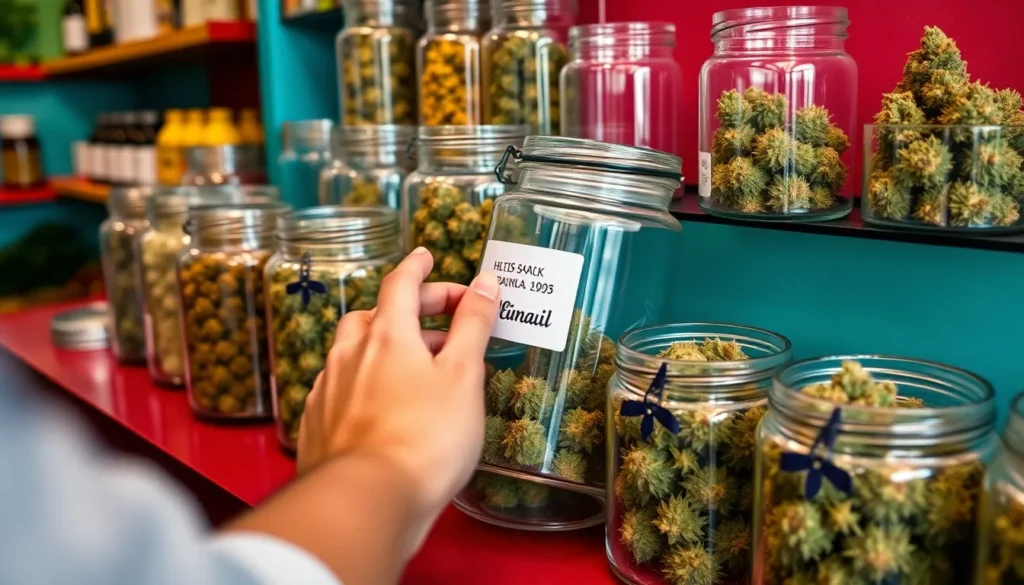Curious about what a zip of weed actually means? You’re not alone! For those dipping their toes into the world of cannabis, the lingo can feel like trying to decipher a secret code. A “zip” isn’t just a catchy term; it’s a slang for an ounce of marijuana, and understanding this can elevate your cannabis knowledge from novice to connoisseur in no time.
Imagine walking into a dispensary, confidently asking for a zip, and watching the budtender’s face light up with approval. It’s like ordering a fine wine, but with a lot more giggles and a lot less sommelier pretension. So, let’s dive into the ins and outs of zips, from how much you really get to what you can do with it. Whether you’re planning a chill night in or gearing up for a social gathering, knowing your zips can make all the difference.
Table of Contents
ToggleUnderstanding Zip Measurements
A zip refers to an ounce of marijuana, equaling approximately 28 grams. Familiarity with this measurement simplifies purchasing decisions for newcomers. Commonly, individuals buy zips to stock up for personal use or social gatherings. Knowing the equivalent in smaller measurements helps as well. For instance, a quarter ounce, or 7 grams, offers an understanding of how much cannabis one can expect from a zip.
Understanding zip measurements also aids in budgeting. A zip typically costs between $150 and $400, depending on potency and supply. High-quality strains may demand higher prices. Budgeting effectively requires awareness of these price ranges.
Cannabis enthusiasts often store zips to ensure freshness. Airtight containers maintain potency and taste. This practice becomes vital, especially for those using marijuana for therapeutic purposes. Fresh cannabis provides enhanced effects.
Grasping how zips fit into larger cannabis quantities is crucial. An ounce serves as a base measurement, with larger quantities like a pound equating to 16 zips. Multitudes of users enjoy sharing zips among friends for social events.
Navigating the cannabis market becomes easier with a solid understanding of zip measurements. Knowledge enables informed purchases and enhances overall experiences, creating enjoyable evenings or relaxed weekends. With zips being a standard measurement, familiarity empowers users during their cannabis journey.
What Is A Zip Of Weed?

A zip of weed refers to an ounce of marijuana, which is approximately 28 grams. Understanding this standard measure is vital for making informed decisions in the cannabis market.
Definition
A zip constitutes a specific quantity of weed, marking it as a popular choice among users. Consumers often prefer this amount for personal use, allowing for ample supply over time. Purchasing a zip frequently offers both convenience and cost-effectiveness. Budtenders often recommend this amount for those collecting different strains. Knowing the exact weight aids in equipping buyers with essential knowledge when browsing dispensaries.
Common Aliases
Several terms accompany the word “zip” in cannabis culture. Slang like “ounce” and “oz” serves as common alternatives, making communication easier among users. People may also hear “heavyweight” in casual settings, adding a layer of informal camaraderie. Connections exist between these terms, as they all reflect the same measurement of 28 grams. Being aware of these aliases enhances conversations around cannabis and cultivates confidence in discussions with peers and dispensary staff.
How Much Is A Zip?
A zip, or ounce, measures approximately 28 grams of weed. This quantity serves as a standard for personal use and purchasing strategies.
Conversion to Other Measurements
Understanding how zips convert to smaller quantities helps users make informed decisions. A quarter ounce equals 7 grams, while an eighth ounce comprises 3.5 grams. Users needing larger amounts should know that a pound (16 zips) translates to 448 grams. This knowledge aids in planning purchases for events or personal consumption. Familiarity with these conversions streamlines communication with dispensary staff and enhances overall cannabis experience.
Pricing Factors
Pricing for a zip varies significantly based on factors such as strain quality and market demand. Users typically encounter costs ranging from $150 to $400 per zip. High-demand strains or premium quality often push prices towards the higher end. Local market trends also play a role, as availability influences pricing. Seasonal factors can affect supply, impacting price fluctuations. Users investing in zips should consider these elements to budget effectively for their cannabis purchases.
Quality of Weed in A Zip
The quality of weed in a zip significantly impacts user experience. Understanding the differences between various strains can enhance enjoyment and therapeutic benefits.
Strain Types
Strain types broadly categorize cannabis into three main groups: indica, sativa, and hybrid. Indica strains often promote relaxation and may assist with sleep. Sativa strains typically provide an energizing effect, ideal for social settings. Hybrid strains blend characteristics of both, catering to diverse preferences. Users may find zips filled with popular strains like GSC, OG Kush, or Blue Dream. Many dispensaries offer strain selections with distinct flavors, aromas, and effects, allowing individuals to choose based on their desired experience. The diversity of strain types ensures that there’s something for everyone.
Potency Considerations
Potency plays a crucial role when evaluating the quality of weed in a zip. Measured in THC percentage, potency influences both the experience and effect duration. Strains with higher THC levels often deliver stronger effects, making them suitable for experienced users. Conversely, strains with lower THC levels can provide a more manageable experience for novices. Many zips contain THC concentrations ranging from 15% to over 30%. Consumers should consider their tolerance levels when selecting a strain based on potency. Evaluating lab testing results can help users make informed decisions, ensuring an enjoyable cannabis experience.
Legal Aspects of Purchasing A Zip
Understanding the legal framework around purchasing a zip of weed is essential for safe and responsible consumption. Regulations vary significantly by state, influencing buying options and user experiences.
State Regulations
State regulations determine the legality of purchasing marijuana. In states where cannabis is legal, dispensaries operate under strict guidelines. Regulations often specify purchase limits, quality standards, and licensing for sellers. For instance, some states allow adults to buy recreational cannabis, while others only permit medical use. Compliance with these regulations ensures safe access for users. Advocates of legalization argue that such measures promote responsible use and enhance public safety.
Age Restrictions
Age restrictions are crucial in the cannabis market. Most states mandate that purchasers must be at least 21 years old for recreational use. Medical users often face a different age minimum, typically set at 18. Checking identification is common practice at dispensaries. Users under the legal age face penalties, including fines or bans from purchasing. Understanding these restrictions protects minors and encourages responsible consumption among adults.
Understanding what a zip of weed is can significantly enhance one’s cannabis experience. This knowledge empowers users to make informed decisions when purchasing and interacting with dispensary staff. By grasping the nuances of strain quality and legal considerations, individuals can navigate the cannabis market more confidently.
Whether it’s for personal use or social gatherings, knowing how to effectively utilize a zip can lead to more enjoyable experiences. As users become familiar with cannabis terminology and measurements, they’ll find themselves better equipped to explore the diverse world of strains available. Embracing this knowledge not only enriches personal consumption but also fosters responsible and informed cannabis use.





